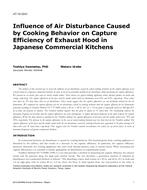-
-
Available Formats
- Options
- Availability
- Priced From ( in USD )
-
Available Formats
-
- Immediate download
- $16.00
- Add to Cart
Customers Who Bought This Also Bought
-

AT-15-C006 -- Effects of Condenser Heat Recovery of a Mul...
Priced From $16.00 -

AT-15-C017 -- Computationally Efficient Heat Pump Model t...
Priced From $16.00 -

AT-15-C050 -- Assessment of Existing Station Ventilation ...
Priced From $16.00 -

AT-15-C041 -- Influence of Air Disturbance Caused by Cook...
Priced From $16.00
About This Item
Full Description
The current diffuser selection guide described in ASHRAE handbook-fundamentals provides a correlation between diffuser characteristics, such as throw length and type, and the performance to distribute supply air and thereby to optimize space air diffusion. The performance of a diffuser is evaluated by using an Air Diffusion Performance Index (ADPI). ADPI is defined as the percentage of occupied zone falling into an acceptable velocity and temperature region determined by measuring effective draft temperature (EDT) that is a calculated temperature difference combining air temperature difference and air speed. However, the EDT was developed in 1960s in terms of limited experimental results of subject experiments, which needs further analysis and more justification. In addition, the current EDT for diffuser selection confines the application to cooling mode only, as stated in ASHRAE Standard-113. This paper presents findings from the project of ASHRAE TRP-1546: Expansion and updating of the Air Diffusion Performance Index Method. In this paper, we analyze the current cooling mode EDT and propose a heating mode EDT by comparing EDT's criteria with Fange's PMV (Predicted Mean Vote) method adopted by ASHRAE Standard-55. The results indicate that the criteria region of current EDT for cooling mode and proposed EDT for heating mode show compliance to that of 80% thermal acceptance predicted by PMV for occupants in the typical office summer and winter condition, respectively.






